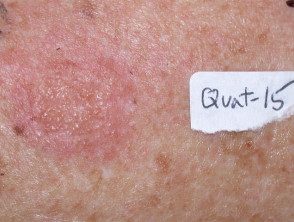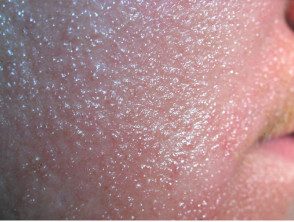What is quaternium-15 and where is it found?
Quaternium-15 is a formaldehyde releasing preservative. It is used in many cosmetics and pharmaceutical preparations. It is also used as a preservative in many commercial and industrial products. The following table shows some of the products that may contain quaternium-15.
| Products containing quaternium-15 | ||
| Cosmetic products | Self-hygiene / pharmaceuticals | Commercial / Industrial Products |
|
|
|
What are the reactions to quaternium-15? allergy?
People who react to quaternium-15 may be sensitive to formaldehyde or have a specific sensitivity. Typical allergic contact dermatitis Reactions of any of these types of sensitivity can occur.

Positive patch tests

Dermatitis of the hand

Facial dermatitis
Am I allergic to quaternium-15?
The allergy to quaternium-15 is diagnosed from the medical history and by conducting special allergy tests, ie. patch tests The patch test with 1% of quaternium-15 in petroleum jelly is used.
A product self-assessment for quaternium-15 is possible, but should be done only after speaking with your doctor first. This should be done only with products designed to stay on the skin, such as cosmetics (not including eyeliners or mascara) and lotions. Apply a small amount of the product to a small sensitive area of the skin, such as the curve of your arm, twice a day for 1 week. Check the area every day, and if no reaction occurs, repeat the test on a small area in front of your ear. If no reaction occurs, it is unlikely that you are allergic to it. Even so, you should be careful if you intend to use it in large areas as it may still be a irritating.
Products such as shampoos, soaps, and cleansers should not be analyzed in this way, as they can cause irritating dermatitis, if covered or overused on sensitive areas.
Treatment of contact dermatitis due to exposure to quaternium-15
If you are diagnosed with an allergy to quaternium-15, avoid exposure to products that contain quaternium-15.
Once dermatitis appears on the skin, treatment is like any other acute dermatitis/eczemathat is to say current corticosteroids emollients, treatment of any secondary bacterial infection (Staphylococcus aureus), etc.
What should I do to avoid a quaternium-15 allergy?
Read product labels and avoid products that contain quaternium-15 or any of its alternative names.
Avoid related substances that you may also be allergic to. This includes formaldehyde and other formaldehyde-releasing preservatives found in cosmetics, topical agents, as well as industrial and metallurgical fluids.
| Formaldehyde releasing preservatives to avoid |
|
Alert your doctor to the fact that you are allergic to quaternium-15. your dermatologist You may have more specific advice, especially if you are very sensitive.
Preparations that contain other types of preservatives, as long as you are not allergic to them, should be safe to use. Ask your pharmacist.
| Possible suitable alternative preservatives |
|
These preservatives can also cause contact allergies.
Alternative names for quaternium-15
Quaternium-15 is also known by various other names. These include:
- Azonium Adamantane Chloride
- N- (3-chloroallyl) hexaminium chloride
- Chloroallylmethanine Chloride
- 1- (3-chloroally) -3,5,7 triaza-1-azoniaadamantane chloride
- Methanamine-3-chloroallylochloride
- Hexamethylenetetramine
- Dowicil®75, Dowicil®100, Dowicil®200
Avoid all this. At work, request a material safety data sheet to help identify potential sources of exposure.
More information
Formula: C9 9HsixteenCl2north4 4
CAS number: 51229-78-8
Cross reactions: formaldehyde, formaldehyde releasing preservatives
Sensitizer formaldehyde
Patch test: 1% of quaternium-15 in petroleum jelly
| Sources of exposure to Quaternium-15 | |
|---|---|
|
|
Reference
Book: Fisher's Contact Dermatitis. Ed Rietschel RL, Fowler JF. Lippincott Williams and Wilkins 2001
